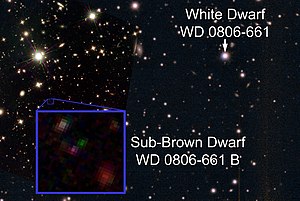Loading AI tools
DQ white dwarf star in the constellation Volans From Wikipedia, the free encyclopedia
WD 0806−661 (L 97-3, GJ 3483), formally named Maru,[9] is a DQ white dwarf with an extremely cold Y-type substellar companion (designated "B"), located in the constellation Volans at 62.7 light-years (19.2 parsecs) from Earth. The companion was discovered in 2011, and is the only known Y-type companion to a star or stellar remnant. At the time of its discovery WD 0806-661 B had the largest actual (2500 AU) and apparent separation (more than 2 arcminutes) of any known planetary-mass object, as well as being the coldest directly imaged substellar object then known.
 The right side shows an image taken by ESO's VLT HAWK-I in near-infrared. The white dwarf is marked with an arrow. The left side shows an image taken by the NASA/ESA HST WFC3 also in near-infrared wavelengths. The sub-brown dwarf appears as green pixels (2014) and purple pixels (2015) in an inset. | |
| Observation data Epoch J2000[1] Equinox J2000[1] | |
|---|---|
| Constellation | Volans |
| Right ascension | 08h 06m 53.75366s[2] |
| Declination | −66° 18′ 16.7011″[2] |
| Characteristics | |
| Spectral type | DQ4.2[3][4] + Y1[5] |
| Apparent magnitude (B) | 13.74[6] / - |
| Apparent magnitude (V) | 13.71[6] / - |
| Apparent magnitude (R) | 13.64[6] / - |
| Apparent magnitude (I) | 13.60[6] / - |
| Apparent magnitude (J) | 13.704 ± 0.023[1] / ~25.42[7] |
| Apparent magnitude (H) | 13.739 ± 0.025[1] / ~25.29[7] |
| Apparent magnitude (K) | 13.781 ± 0.043[1] / - |
| Astrometry | |
| Proper motion (μ) | RA: 335.519(16) mas/yr[2] Dec.: −288.994(17) mas/yr[2] |
| Parallax (π) | 51.9970 ± 0.0141 mas[2] |
| Distance | 62.73 ± 0.02 ly (19.232 ± 0.005 pc) |
| Absolute magnitude (MV) | 12.30[6] / - |
| Details | |
| Component A | |
| Mass | 0.58 ± 0.03[6] M☉ |
| Surface gravity (log g) | 8.00 ± 0.05[6] cgs |
| Temperature | 10205 ± 390[6] K |
| Age | 1.5–2.7[7] Gyr |
| Component B | |
| Mass | 7–9[7] MJup |
| Surface gravity (log g) | 4.2–4.3[7] cgs |
| Temperature | 325–350[7] K |
| Metallicity | <0[7] |
| Position (relative to A) | |
| Component | B |
| Angular distance | 130.2 ± 0.2″ [8] |
| Position angle | 104.2 ± 0.2° [8] |
| Projected separation | 2500 AU [8] |
| Other designations | |
| Database references | |
| SIMBAD | data |
Component WD 0806-661 B was discovered in 2011 with the Spitzer Space Telescope. Its discovery was announced in the paper Luhman et al., 2011. The secondary has a mass between 7 and 9 MJ and a temperature between 325 and 350 kelvins (52 and 77 °C; 125 and 170 °F).[7] At the time of its discovery, WD 0806−661 B was the coldest "brown dwarf" that has ever been found.[8] The object is too faint to acquire a spectrum even with the Hubble Space Telescope, however the spectral type of this object was estimated to be Y1 based on its detection in Hubble images at near-infrared wavelengths.[5] The photometric colors of this object suggest that it is metal-poor. The metal-poor composition of the companion could explain the DQ spectral type of the primary white dwarf.[7] Hydrogen-deficient AGB stars might evolve into DB white dwarfs and then into DQ white dwarfs as they cool down.[10]
In August 2022, WD 0806-661 and its planetary-mass companion were included among 20 systems to be named by the third NameExoWorlds project.[11] The approved names, proposed by a team from South Korea, were announced in June 2023. WD 0806-661 is named Maru and its companion is named Ahra, after Korean words meaning "sky" and "ocean".[9]
Seamless Wikipedia browsing. On steroids.
Every time you click a link to Wikipedia, Wiktionary or Wikiquote in your browser's search results, it will show the modern Wikiwand interface.
Wikiwand extension is a five stars, simple, with minimum permission required to keep your browsing private, safe and transparent.